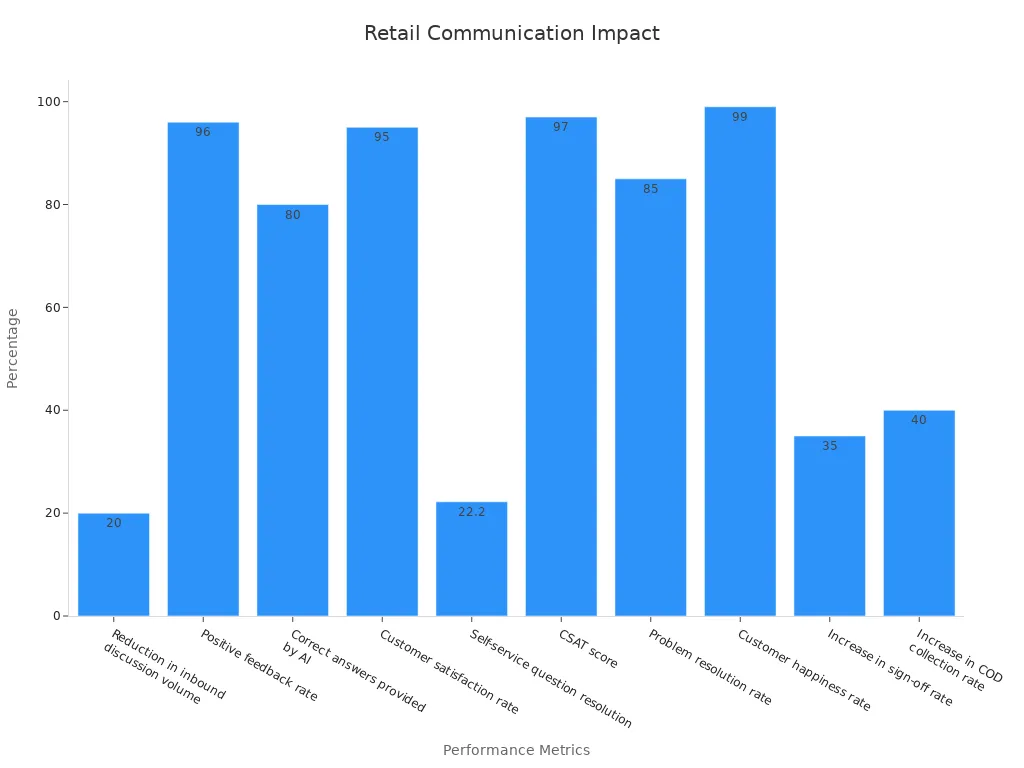Real Retail Fails: Customer Service Horror Stories

Imagine walking into a store, excited to shop, only to be met with a staff member who barely acknowledges you. Frustrating, right? Customer service can make or break a retail experience, and businesses know it. Retail brands that prioritize service have seen a 15% boost in customer retention, while others suffer losses as poor service costs companies $75 billion annually. Even one bad experience can drive away half of your customers, and 95% of them will share their disappointment. The stakes are high, and the lessons from bad customer service examples in retail are invaluable. To avoid such pitfalls, many businesses are turning to solutions like Sobot, which enhance customer interactions and improve overall service quality.
Defining Bad Customer Service in Retail
What Constitutes Bad Customer Service?
Bad customer service can take many forms, but it all boils down to one thing: unmet expectations. When you walk into a store or interact with a brand, you expect a certain level of respect, efficiency, and knowledge. Unfortunately, not all businesses deliver.
Here are some common culprits that define bad customer service:
- Poor products or services that fail to meet basic standards.
- Overworked or dissatisfied staff who lack the energy or motivation to assist you.
- Incompetent employees who don’t know enough about the products they’re selling.
- A lack of real-time support when you need immediate help.
- Repeatedly unresolved issues, forcing you to explain your problem to multiple representatives.
These experiences can turn what should be a simple shopping trip into a nightmare. And in today’s competitive retail world, where e-commerce is thriving, businesses can’t afford to drop the ball.
Common Standards for Good vs. Bad Service
How do you tell good service from bad? It’s all about meeting—or exceeding—expectations. Let’s break it down:
| Benchmark Type | Good Service Example | Bad Service Example |
|---|---|---|
| Overall Satisfaction | Customers leave happy and feel valued. | Customers leave frustrated or ignored. |
| Associate Friendliness | Staff greet you warmly and offer assistance. | Staff avoid eye contact or use inappropriate language. |
| Speed of Checkout | You’re in and out quickly, even during busy hours. | Long lines and slow systems waste your time. |
| Product Availability | Items are well-stocked and easy to find. | Shelves are empty, and no one knows when items will be restocked. |
| Likelihood to Recommend | You’d happily tell your friends about the store. | You warn others to avoid it at all costs. |
When businesses fail to meet these benchmarks, they risk losing loyal customers to competitors who do.
Consequences of Poor Customer Service in Retail
The fallout from bad customer service is real—and costly. Did you know that 76% of consumers say a single bad experience changes how they view a brand? Worse, one in three customers will stop shopping with a business entirely after a poor interaction.
Take Walmart’s price-matching mistake, for example. A customer couldn’t get a price match for an item listed on Walmart’s own website. The result? Frustration, inconvenience, and a tarnished reputation. Or consider Comcast’s infamous name-change blunder, where a representative altered a customer’s name to an offensive term. That incident didn’t just go viral—it became a PR disaster.
These examples show how bad customer service doesn’t just hurt your bottom line. It damages your reputation, and in today’s social media-driven world, that damage can spread like wildfire.
Bad Customer Service Examples in Retail: Poor Communication
The Misinformed Employee: A Case Study
Have you ever asked a store employee a simple question, only to receive a blank stare or incorrect information? It’s frustrating, isn’t it? Poor communication often starts with employees who lack proper training or access to accurate information. Take Sears, for example. The retail giant faced countless complaints about unhelpful staff and unsatisfactory in-store experiences. Customers reported employees who couldn’t answer basic questions about products or store policies. This communication breakdown contributed to Sears’ decline in customer loyalty and eventual bankruptcy.
Another case is Huawei, which saw its customer satisfaction rating drop by 15% due to poor after-sales support. Customers felt abandoned when they couldn’t get clear answers about warranties or repairs. These bad customer service examples in retail highlight how misinformation can turn a shopping trip into a nightmare.
When employees don’t have the tools or knowledge to communicate effectively, customers lose trust. Businesses must prioritize training and equip their teams with real-time access to product details, policies, and customer data.
Silent Treatment at the Register: A Real-Life Example
Imagine standing at the checkout counter, ready to pay, but the cashier doesn’t even look up. No greeting, no acknowledgment—just silence. This scenario is more common than you might think. A study revealed that 40% of Go-Jek users experienced similar issues with unresponsive customer service, leading to a 12% drop in active users.
British Airways faced a similar backlash during an IT meltdown. Customers were left stranded without updates or explanations, causing widespread frustration. Poor communication during critical moments can leave customers feeling ignored and undervalued.
In retail, the checkout experience is often the last interaction a customer has with your brand. If it’s cold or dismissive, it can overshadow an otherwise positive shopping experience. A simple “Hello” or “Thank you for shopping with us” can make all the difference.

How Sobot’s Voice/Call Center Can Improve Communication
Effective communication is the backbone of great customer service. Sobot’s Voice/Call Center offers tools that help businesses bridge the communication gap. With features like Intelligent IVR, you can route calls to the right agent instantly, ensuring customers get accurate answers without being bounced around.
The Unified Workspace consolidates customer data, call history, and inquiries into one platform. This allows agents to provide personalized responses and resolve issues faster. Plus, the AI-powered Voicebot handles repetitive queries, freeing up human agents to focus on complex problems.
Here’s how Sobot’s Voice/Call Center has transformed retail communication:
| Metric/Review Description | Value/Outcome |
|---|---|
| Reduction in inbound discussion volume | 20% |
| Positive feedback rate | 96%+ |
| Correct answers provided by AI | 80%+ |
| Customer satisfaction rate | 95%+ |
| Self-service question resolution | 22.2% |
| CSAT score | 97% |
| Problem resolution rate | 85% |
| Customer happiness rate | 99% |
| Increase in sign-off rate | 35% |
| Increase in COD collection rate | 40% |

Sobot’s solutions don’t just improve communication—they enhance the overall customer experience. By reducing wait times and providing accurate information, businesses can rebuild trust and loyalty.
Lack of Empathy: The Customer Is Not Always Wrong

The "Policy Robot" Employee: A Horror Story
Have you ever dealt with an employee who sticks to the rulebook like a robot, even when it makes no sense? Imagine this: You’re returning a defective product, and instead of understanding your frustration, the employee repeats, “It’s against our policy.” No empathy. No effort to help. Just a cold, mechanical response.
This kind of interaction can turn loyal customers into nightmare customers. A recent survey revealed that only 34% of customers felt they were treated with empathy during service interactions. Worse, 80% of customers admitted they switched brands due to poor customer experiences, often triggered by unhelpful employees.
Empathy matters. It’s not just about following policies but understanding the human side of every situation. When employees fail to connect with you, it feels like the brand doesn’t care. And that’s a dealbreaker for most shoppers.
Ignoring Customer Complaints: A Retail Nightmare
Ignoring complaints is one of the worst forms of bad customer service. Picture this: You’ve emailed a store about a damaged item, but weeks go by without a response. Frustrating, right?
The numbers don’t lie. Studies show that 86% of consumers will leave a brand after two poor experiences, and 17% of U.S. customers will abandon a brand after just one. Globally, that number jumps to 32%. Brands that ignore complaints risk losing not just one customer but their entire reputation.
Listening to feedback isn’t optional. It’s essential for maintaining trust and loyalty. Brands that fail to address complaints often find themselves in a downward spiral, losing both customers and credibility.
Leveraging Sobot AI Solutions for Empathetic Customer Interactions
Empathy can’t always be taught, but it can be supported. Sobot AI solutions help businesses deliver empathetic customer service by automating routine tasks and freeing up agents to focus on meaningful interactions.
With Sobot’s AI copilots, agents receive real-time suggestions for empathetic responses, ensuring every customer feels heard. The platform’s omnichannel support allows you to address complaints across chat, email, and social media seamlessly. Businesses using Sobot AI report a 30% increase in customer satisfaction and a 20% boost in sales conversions.
By integrating Sobot AI, you can transform bad customer service into memorable experiences. It’s not just about solving problems—it’s about showing customers you care.
Procedural Failures: When Systems Break Down
The Never-Ending Return Process: A Frustrating Example
Returning a product should be simple, right? Unfortunately, for many customers, it’s anything but. Imagine buying a defective item, only to face endless hurdles when trying to return it. This isn’t just inconvenient—it’s infuriating.
Here’s what often goes wrong:
- Limited Visibility: Over half of retailers struggle to track returned products effectively. This lack of transparency leaves customers waiting for updates that never come.
- Disagreements Over Responsibility: Two-thirds of retailers face disputes over vendor credits, with half of credit requests denied. For example, if 70,000 iPhones are returned and half of the credits are rejected, the retailer loses $35,000.
- Time Delays: More than half of retailers report waiting over four weeks to receive vendor credits. This ties up working capital and frustrates customers who expect quick resolutions.
These procedural failures don’t just create bad customer service—they turn loyal shoppers into nightmare customers. When you’re stuck in a never-ending return process, it feels like the brand doesn’t value your time or money.
Sobot’s Unified Workspace can help retailers avoid these pitfalls. By centralizing customer data and automating workflows, it streamlines the return process. Agents can access real-time information, resolve disputes faster, and keep customers informed every step of the way.
Outdated Technology Leading to Customer Frustration
Technology should make shopping easier, but outdated systems often do the opposite. Have you ever tried using a self-checkout machine that freezes or crashes? It’s frustrating, isn’t it?
Here’s how outdated technology impacts the customer experience:
- Self-checkout systems often fail to deliver on speed and functionality, leaving you impatient and annoyed.
- Poorly designed interfaces confuse customers, making the checkout process slower and more stressful.
- Retail workers spend more time dealing with frustrated customers, with 68.5% reporting regular complaints about long wait times.
Frustration levels have skyrocketed by 126% since 2023, and 65% of shoppers feel disrespected while waiting for outdated systems to work. These failures don’t just hurt your mood—they damage your perception of the brand.
Retailers need to prioritize modern, user-friendly technology to enhance customer satisfaction. Sobot’s AI solutions can optimize self-checkout systems and automate repetitive tasks, ensuring smoother interactions. With features like real-time speech recognition and omnichannel support, Sobot helps businesses deliver a seamless experience that keeps customers coming back.
How Sobot’s Unified Workspace Streamlines Retail Operations
When systems break down, it’s not just customers who suffer—your employees do too. Disorganized workflows and outdated tools make it harder for staff to resolve issues quickly. That’s where Sobot’s Unified Workspace comes in.
This all-in-one platform centralizes customer data, inquiries, and call history, giving your team everything they need in one place. Here’s how it helps:
- Faster Resolutions: Agents can access real-time information to solve problems quickly.
- Improved Communication: With integrated tools, your team can provide accurate answers without bouncing customers between departments.
- Enhanced Efficiency: Automated workflows reduce manual tasks, freeing up employees to focus on complex issues.
Retailers using Sobot’s Unified Workspace have reported a 35% increase in sign-off rates and a 40% boost in COD collection rates. By streamlining operations, you can turn procedural failures into opportunities for exceptional service.
The Ripple Effect: Viral Impact of Bad Customer Service

Social Media Backlash: A Single Incident Gone Viral
Social media can amplify a single bad customer service experience into a full-blown crisis. One small mistake can snowball into a viral post, damaging your brand’s reputation in hours. Take FairPrice, for example. A minor technical glitch led to a wave of public backlash online. The company’s lack of immediate response only fueled the fire, showing how unprepared crisis management can escalate issues. Similarly, the Emilia Pérez fallout demonstrated how a single incident can tarnish a brand’s image. Customers took to social media, sharing their frustrations, and the brand struggled to recover.
These examples highlight the importance of having a robust crisis management plan. Retailers must monitor social media channels actively and respond promptly to complaints. Tools like Sobot’s AI-powered insights can help you track customer sentiment in real time, allowing you to address issues before they spiral out of control.
Negative Reviews and Their Long-Term Impact
Negative reviews don’t just hurt your feelings—they hurt your bottom line. Studies show that poor online ratings can lead to sustained decreases in retail performance. Here’s a closer look at the data:
| Study | Findings | Link |
|---|---|---|
| Fornell et al. (2016) | ACSI scores correlate with abnormal stock returns. | Link |
| Junran et al. (2020) | Consumer reviews significantly impact stock performance. | Link |
| Huang (2018) | Ratings strongly associate with stock prices. | Link |
When customers see a flood of negative reviews, they lose trust in your brand. Worse, potential buyers may never even give you a chance. That’s why addressing complaints and improving service is critical. Sobot’s AI solutions can analyze review trends and provide actionable insights to help you turn things around.
Damage Control with Sobot’s AI-Powered Insights
Recovering from bad customer service incidents requires more than apologies. You need data-driven strategies to rebuild trust. Sobot’s AI-powered insights offer exactly that. By analyzing customer feedback and sentiment, Sobot helps you identify pain points and resolve them proactively. Here’s how it works:
| Statistic Description | Result |
|---|---|
| NPS Improvement | 15% higher for AI users |
| Decrease in Repeat Calls | 50% reduction |
| FCR Rate Improvement | 10% increase |
| Reduction in Post-Call Work | 25% less work for agents |
| Sentiment Analysis Accuracy | 85% accuracy |

With Sobot, you can predict customer needs, resolve issues faster, and improve satisfaction rates. It’s not just about fixing problems—it’s about showing your customers that you care. By leveraging AI, you can turn a potential PR disaster into an opportunity to strengthen your brand.
Bad customer service doesn’t just frustrate—it costs businesses billions and drives customers away. Seven out of ten customers stop shopping with a brand after a poor experience, and dissatisfied shoppers share their stories twice as often as happy ones. Fixing these issues starts with prioritizing empathy, communication, and streamlined systems.
Great service isn’t optional—it’s your ticket to loyalty and growth.
Have a story to share? Drop it in the comments below. Let’s learn from each other and make retail better for everyone!
| Statistic | Source |
|---|---|
| Only one in five customers who gave a company a poor customer service experience rating are likely to purchase more goods from the company in the future. | Qualtrics’ “ROI of Customer Experience, 2020” |
| Seven out of 10 customers have stopped doing business with a brand due to a poor customer service experience. | Verint |
| Dissatisfied customers tell twice as many people about their poor customer service experience as those with a positive customer experience. | CCMC (2020 National Customer Rage Study) |
FAQ
What is bad customer service in retail?
Bad customer service happens when your expectations aren’t met. It could be rude staff, slow checkout, or unresolved issues. These moments make you feel undervalued and frustrated, leaving a negative impression of the brand.
How can poor communication affect my shopping experience?
Poor communication leads to confusion and frustration. Imagine asking for help and getting wrong answers or no response at all. It makes you feel ignored and can ruin your trust in the store.
Why does empathy matter in customer service?
Empathy shows you that the brand cares about your experience. When employees understand your concerns, you feel valued. Without empathy, interactions feel robotic and cold, driving you away from the brand.
How can Sobot improve customer service?
Sobot uses AI to streamline communication and operations. It helps agents provide faster, more accurate responses. With tools like AI copilots and unified workspaces, Sobot ensures you get the help you need without delays.
Can bad customer service really hurt a business?
Absolutely! Bad service drives customers away and damages a brand’s reputation. Negative reviews and viral complaints can spread quickly, costing businesses millions. Great service isn’t just nice—it’s essential for growth.
See Also
Excelling At Live Chat Within The Retail Sector
Shopify Live Chat: Genuine Experiences From Users
Enhancing Live Chat Effectiveness In Retail Environments
